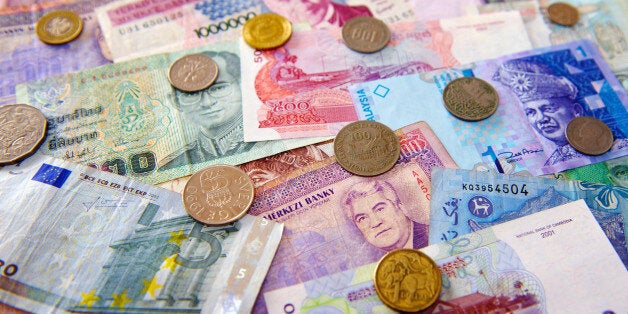
SANTIAGO -- Consider the following scenario, one that has played out time and again in emerging-market countries. Local banks and firms go on a borrowing binge and pile up dollar-denominated debt -- debt that pundits consider perfectly sustainable, as long as the local currency is strong. Suddenly, something (an increase in United States interest rates, a drop in commodity prices, a domestic political conflict) causes the local currency to drop in value against the dollar. The debt burden, measured in domestic currency, is now much higher. Some borrowers miss interest payments; others are unable to roll over principal. Financial mayhem ensues.
This is how the Latin American debt crisis of the 1980s, the Mexican Tequila crisis of 1994, the Asian debt crisis of 1997, and the Russian crisis of 1998 unfolded. It was also how the financial crisis of 2008-2009 transmitted itself to emerging markets. Every time, borrowers and lenders claimed to have learned their lesson.
Not only could it happen again today; it could happen on a much larger scale than in the past. Taking advantage of ultra-low interest rates in advanced countries, emerging-market banks and firms have been borrowing like never before. A recent paper by the Bank for International Settlements shows that since the global financial crisis, outstanding dollar credit to non-bank borrowers outside the U.S. has risen by half, from $6 trillion to $9 trillion.
The bulk of that debt is in Asia, with China alone accounting for approximately $1 trillion. Other big dollar borrowers include Brazil (over $300 billion) and India ($125 billion). Countries such as Malaysia, South Africa, and Turkey, plus Latin America's more financially open economies, also have rising foreign-currency debts.
Yes, the almighty dollar is not as mighty as it was before the U.S. Federal Reserve surprised markets with a more-dovish-than-expected communiqué earlier this month. But, given the likely interest-rate differential between the U.S. and other advanced economies (particularly the eurozone and Japan), together with a more robust U.S. economic recovery, an era of dollar strength -- and, almost by definition, weak emerging-market currencies -- is here to stay.
This likely means trouble for the firm that borrowed in dollars to build a shopping mall in São Paulo or Kuala Lumpur, and now must devote a much larger share of its revenues in depreciated real or ringgit to service its debt.
How did we get here? Once upon a time, conventional wisdom maintained that curbing governments' appetite for debt would put an end to over-borrowing, because private agents would know to act prudently and weigh the costs and benefits of one more dollar of debt.
Not even stern University of Chicago economists believe that anymore. The fiscal and debt position of many emerging economies (though not of Argentina, Venezuela, and other poster children for mismanagement) is much stronger than it once was. But private-sector CFOs seem determined to prove that they can borrow as lavishly as their public-sector colleagues once did.
Conventional wisdom also once held that dollar borrowing binges occur only in countries with fixed exchange rates, with the central bank de facto insuring borrowers against currency risk. Today, most emerging-market economies have (or at least pretend to have) floating exchange rates, and yet locals continue to borrow heavily in foreign currency.
This partly reflects borrowing-cost differentials. If the local interest rate is 17 percent per year and the dollar interest rate is 2 percent, it still makes sense to borrow in dollars as long as the domestic currency is expected to depreciate 15 percent or less.
The other part of the explanation follows from what the economists Guillermo Calvo and Carmen Reinhart call "fear of floating." Many market participants know from past experience (recall 2008-2009, for example) that emerging economies' central banks fear sharp depreciations, and that in moments of stress they tend to intervene, at least temporarily, to support the exchange rate, "smoothing" its decline. So a speculator who is quick on his feet can make a handsome profit and get out while the music is still playing.
How vulnerable are emerging economies because of all this dollar debt? Optimists like to point out that emerging markets have accumulated a huge stock of international reserves since 2010, enabling them to self-insure against a run on their currencies or their foreign debt. That is true, but only up to a point.
Having tens or even hundreds of billions of dollars in the central bank's vault sounds reassuring until you realize that dollar debt coming due in the next 12 months may not be that much smaller. The data are not fully reliable or comparable across countries, but quick calculations reveal that there are many emerging markets where such short-term debt is 50 percent or more of the stock of international reserves.
And dollar debtors may not be alone in staking a claim on those reserves. In a squeeze, holders of domestic currency will want to exchange it for greenbacks. If the central bank is serious about floating, it will hike local interest rates to limit price increases, causing a painful recession. Alternatively, it may intervene and sell international reserves, reducing the stock available to repay dollar debt.
Optimists also argue that some local borrowers are naturally hedged. Yes, some export companies that borrow dollars also earn dollars. But they are in the minority, and even they can have problems, because depreciation reduces the dollar value of their domestic assets, causing breaches in loan covenants and potentially impairing access to credit.
There are risks even for banks that make the effort to match their dollar borrowing from abroad with dollar loans extended at home. There may be no obvious currency mismatch for the bank, but if the local borrowers' revenues are only in domestic currency, they may become unable to service their debt. Risk eliminated by regulations in one place reappears somewhere else.
For the many emerging market firms that borrowed in dollars to generate local-currency revenue, the recent depreciation is triggering plenty of financial trouble. How much trouble will ultimately depend on factors that are very hard to forecast, including markets' responses to Fed tightening and political shocks (say, the scandal enveloping Petrobras in Brazil) that shake investors' faith in local policies and markets. One can predict only one outcome with confidence: a bumpy ride.
